
Apollo is one of the Olympian deities in classical Greek and Roman religion and Greek and Roman mythology. Apollo has been recognized as a god of archery, music and dance, truth and prophecy, healing and diseases, the Sun and light, poetry, and more. One of the most important and complex of the Greek gods, he is the son of Zeus and Leto, and the twin brother of Artemis, goddess of the hunt. He is considered to be the most beautiful god and is represented as the ideal of the kouros. Apollo is known in Greek-influenced Etruscan mythology as Apulu.

In ancient Greek religion and mythology, Artemis is the goddess of the hunt, the wilderness, wild animals, nature, vegetation, childbirth, care of children, and chastity. In later times, she was identified with Selene, the personification of the Moon. She was often said to roam the forests and mountains, attended by her entourage of nymphs. The goddess Diana is her Roman equivalent.

Delphi, in legend previously called Pytho (Πυθώ), was an ancient sacred precinct and the seat of Pythia, the major oracle who was consulted about important decisions throughout the ancient classical world. The ancient Greeks considered the centre of the world to be in Delphi, marked by the stone monument known as the Omphalos of Delphi (navel).

The statue of Athena Parthenos was a monumental chryselephantine sculpture of the goddess Athena. Attributed to Phidias and dated to the mid-fifth century BCE, it was an offering from the city of Athens to Athena, its tutelary deity. The naos of the Parthenon on the acropolis of Athens was designed exclusively to accommodate it.

A sacrificial tripod, whose name comes from the Greek meaning "three-footed", is a three-legged piece of religious furniture used in offerings and other ritual procedures. This ritual role derives from its use as a simple support for a cooking vessel placed over a fire. As a seat or stand, the tripod is the most stable furniture construction for uneven ground, hence its use is universal and ancient.

The Charioteer of Delphi, also known as Heniokhos, is a statue surviving from Ancient Greece, and an example of ancient bronze sculpture. The life-size (1.8m) statue of a chariot driver was found in 1896 at the Sanctuary of Apollo in Delphi. It is now in the Delphi Archaeological Museum.

The stater was an ancient coin used in various regions of Greece. The term is also used for similar coins, imitating Greek staters, minted elsewhere in ancient Europe.

The sculpture of ancient Greece is the main surviving type of fine ancient Greek art as, with the exception of painted ancient Greek pottery, almost no ancient Greek painting survives. Modern scholarship identifies three major stages in monumental sculpture in bronze and stone: the Archaic, Classical (480–323) and Hellenistic. At all periods there were great numbers of Greek terracotta figurines and small sculptures in metal and other materials.

The Siphnian Treasury was a building at the Ancient Greek cult centre of Delphi, erected to host the offerings of the polis, or city-state, of Siphnos. It was one of a number of treasuries lining the "Sacred Way", the processional route through the Sanctuary of Apollo, erected to win the favor of the gods and increase the prestige of the donor polis. It was one of the earlier surviving buildings of this type, and its date remains a matter for debate, with the most plausible date being around 525 BC. Until recently it was often confused or conflated with the neighbouring Cnidian Treasury, a similar but less elaborate building, as the remains of the two had become mixed together and earlier theoretical reconstructions used parts of both.

Chryselephantine sculpture is sculpture made with gold and ivory. Chryselephantine cult statues enjoyed high status in Ancient Greece.
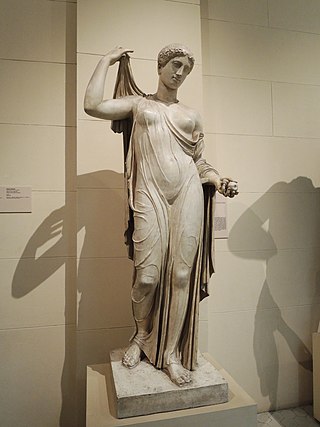
Callimachus was an architect and sculptor working in the second half of the 5th century BC in the manner established by Polyclitus. He was credited with work in both Athens and Corinth and was probably from one of the two cities. According to Vitruvius (iv.1), for his great ingenuity and taste the Athenians dubbed Callimachus katatêxitechnos. His reputation in the 2nd century AD was reported in an aside by Pausanias as one "although not of the first rank of artists, was yet of unparalleled cleverness, so that he was the first to drill holes through stones"—that is, in order to enhance surface effects of light and shade in locks of hair, foliage and other details. Thus it is reported that Callimachus was known for his penchant for elaborately detailed sculptures or drapery, though few securely attributed works by him survive.
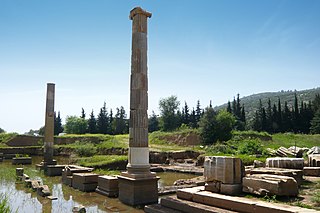
Claros was an ancient Greek sanctuary on the coast of Ionia. It contained a temple and oracle of Apollo, honored here as Apollo Clarius. It was located in the territory of Colophon, which lay twelve kilometers to the north, one of the twelve cities of the Ionian League. The coastal city Notion lay two kilometers to the south. The ruins of the sanctuary are now found north of the modern town Ahmetbeyli in the Menderes district of Izmir Province, Turkey.
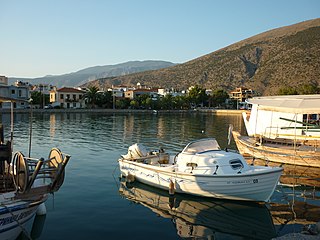
Kirra is a village in Phocis, Central Greece. It is part of the municipal unit of Itea, to which it is adjacent. Kirra is the point where the Pleistos river meets the Gulf of Iteas, a bay of the Gulf of Corinth.

The Temple of Apollo, also known as Apollonion, was a major part of the Panhellenic religious sanctuary located in Central Greece at Delphi. The temple and sanctuary at large were dedicated to one of the major Greek deities, Apollo, the god of archery, music, light, prophecy, the arts, and healing. There have been several temples built at Delphi throughout the history of the site, though the visible ruins seen in modernity are those of the temple built in the 4th century B.C.E. before its destruction under the orders of Theodosius I in 390 C.E.. During antiquity, the temple was home to the famous Greek prophetess the Pythia, or the Oracle of Delphi, making the Temple of Apollo and the sanctuary at Delphi a major Panhellenic religious site as early as the 8th century B.C.E., and a place of great importance at many different periods of ancient Greek history. References to Delphi, the sanctuary, the temple, and the prophecies of the Pythia are made throughout ancient Greek mythology and historical accounts from the periods of its use.

Delphi Archaeological museum is one of the principal museums of Greece and one of the most visited. It is operated by the Greek Ministry of Culture. Founded in 1903, it has been rearranged several times and houses the discoveries made at the Panhellenic sanctuary of Delphi, which date from the Late Helladic (Mycenean) period to the early Byzantine era.
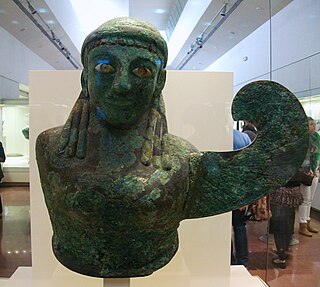
A sphyrelaton is a term used for a type of archaic Greek bronze votive statues of considerable size.

Ancient Greek art stands out among that of other ancient cultures for its development of naturalistic but idealized depictions of the human body, in which largely nude male figures were generally the focus of innovation. The rate of stylistic development between about 750 and 300 BC was remarkable by ancient standards, and in surviving works is best seen in sculpture. There were important innovations in painting, which have to be essentially reconstructed due to the lack of original survivals of quality, other than the distinct field of painted pottery.

The Palaikastro Kouros is a chryselephantine statuette of a male youth (kouros) excavated in stages in the modern-day town of Palaikastro on the Greek island of Crete. It has been dated to the Late Minoan 1B period in the mid-15th century BC, during the Bronze Age. It is now on display in the Archaeological Museum of Siteia. Standing roughly 50 cm tall, its large size by the standards of other figurines in Minoan art, and the value of its materials may indicate that it was a cult image for worship, the only one known from the Minoan civilization.
Among the famous ex votos of Delphi was that of Craterus, friend and general of Alexander the Great, attributed to Lysippos.
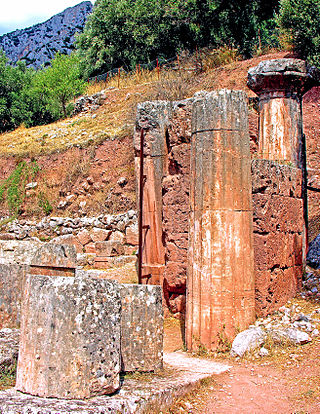
The Temple of Athena Pronaia was a temple at the ancient site of Delphi, in the Sanctuary of Athena Pronaia, a group of buildings comprising temples and treasuries as well as the famous Tholos of Delphi. There were in fact three successive temples built at the site. The earlier temples (38°28′49″N22°30′30″E), referred to as A and B, were built in the 7th and 6th centuries BC respectively and were made of porous stone; a third temple (38°28′49″N22°30′28″E) was built of limestone in the 4th century BC, although it is not certain that it actually was dedicated to Athena this time.




















